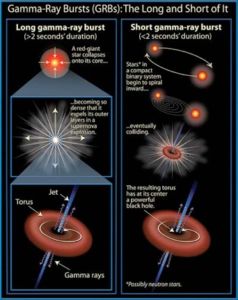In news
Indian astronomers’ were part of a team which spotted the first short duration gamma-ray burst from a stellar collapse.
About GRB 200826A
- It was a very short, powerful burst of high-energy radiation that lasted for about a second and had been racing toward Earth for nearly half the present age of the universe.
- The burst detected by NASA’s Fermi Gamma-ray Space Telescope on August 26, 2020, turned out to be one for the record books – the shortest gamma-ray burst (GRB) caused by the death of a massive star.
- The burst emitted 14 million times the energy released by the entire Milky Way galaxy over the same amount of time, making it one of the most energetic short-duration GRBs ever seen.
- GRB 200826A was a sharp blast of high-energy emission lasting just 0.65 seconds.
- After traveling for eons through the expanding universe, the signal had stretched out to about one-second-long when it was detected by Fermi’s Gamma-ray Burst Monitor.
- Named GRB 200826A, after the date it occurred, the burst is the subject of two papers published in Nature Astronomy on July 26.
- The first, led by Zhang, explores the gamma-ray data.
- The second, led by Tomás Ahumada, a doctoral student at the University of Maryland, College Park, and NASA’s Goddard Space Flight Center in Greenbelt, Maryland.
Why is it a unique thing?
- Scientists already knew some GRBs from massive stars could register as short GRBs, but they thought this was due to instrumental limitations. Now scientists know dying stars can produce short bursts.
- Such a discovery has helped to resolve the long-standing issues related to gamma-ray bursts.
- Also, this study triggers to re-analyse all such known events to constrain number densities better.
Participation of Indian scientists
The team included scientists from:
- Aryabhatta Research Institute of Observational Sciences (ARIES) of DST.
- The Inter-University Centre for Astronomy and Astrophysics, Pune (IUCAA).
- National Centre for Radio Astrophysics – Tata Institute of Fundamental Research, Pune (NCRA)
- IIT Mumbai.
What are Gamma ray bursts(GRBs)?
- GRBs are the most powerful events in the universe, detectable across billions of light-years.
- They produce thousands of times more energy than Supernovae and their distinctive gamma-ray emission lasts from a fraction of seconds to only a few minutes.
- Historically this was the first distinction between long-GRB and short-GRB.
- Astronomers classify them as long or short based on whether the event lasts for more or less than two seconds.
Long bursts
- The long class of GRBs is probably due to the explosion of a very massive star (~30 times our sun) which collapses and explodes producing a black-hole and emitting most of its energy in the form of jets.
- Astronomers only detect a GRB when one of these jets happens to point almost directly toward Earth.
- Each jet drills through the star, producing a pulse of gamma rays – the highest-energy form of light – that can last up to minutes.
- Following the burst, the disrupted star then rapidly expands as a supernova.

Short bursts
- Short GRBs are probably due to the coalescence of a binary system of 2 compact objects (two neutron stars or a neutron star and a white dwarf).
- It also forms during stellar collapse – spiral inward over billions of years and collide.
Fermi Gamma-ray Space Telescope
- Formerly called the Gamma-ray Large Area Space Telescope (GLAST), is a space observatory being used to perform gamma-ray astronomy observations from low Earth orbit.
- Launched on June 11, 2008, the Fermi Gamma-ray Space Telescope observes the cosmos using the highest-energy form of light.
- Mapping the entire sky every three hours, Fermi provides an important window into the most extreme phenomena of the universe, from gamma-ray bursts and black-hole jets to pulsars, supernova remnants and the origin of cosmic rays.
- It is operated by NASA.
- Its main instrument is the Large Area Telescope (LAT) for all-sky survey studying.
- Another instrument aboard Fermi, the Gamma-ray Burst Monitor is being used to study gamma-ray bursts and solar flares.
















